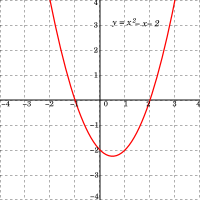Quadratic function

Okay kiddo, so let's imagine you have a treasure chest and you want to know how much treasure it can hold. The problem is, you don't want to pour all your treasure in the chest right away, you want to figure it out mathematically first.
That's where the quadratic function comes in. It's like a magic formula that helps you figure out how much treasure your chest can hold without actually pouring it all in.
A quadratic function is a special kind of math formula that helps us calculate how much something will change based on another thing changing. It looks like this: y = ax² + bx + c.
Now, let's break it down into smaller pieces. "Y" is the treasure you're trying to find out. "X" is how much space you're adding to the treasure chest. "A", "B", and "C" are just special numbers that we use to help us figure out how much treasure can fit in the chest.
The "A" number tells us how much treasure we can add for each "X" we add. The bigger the "A" number, the more treasure we can add.
The "B" number tells us the normal amount of treasure we can add. It's like a baseline amount.
The "C" number tells us how much treasure is already in the chest before we start adding any more.
So, when you write out a quadratic function, it helps you figure out how much treasure your chest can hold without ever pouring it all in. And that's a really useful tool to have, especially when you don't want to risk losing all your treasure by pouring it into a chest that might not hold it all.
That's where the quadratic function comes in. It's like a magic formula that helps you figure out how much treasure your chest can hold without actually pouring it all in.
A quadratic function is a special kind of math formula that helps us calculate how much something will change based on another thing changing. It looks like this: y = ax² + bx + c.
Now, let's break it down into smaller pieces. "Y" is the treasure you're trying to find out. "X" is how much space you're adding to the treasure chest. "A", "B", and "C" are just special numbers that we use to help us figure out how much treasure can fit in the chest.
The "A" number tells us how much treasure we can add for each "X" we add. The bigger the "A" number, the more treasure we can add.
The "B" number tells us the normal amount of treasure we can add. It's like a baseline amount.
The "C" number tells us how much treasure is already in the chest before we start adding any more.
So, when you write out a quadratic function, it helps you figure out how much treasure your chest can hold without ever pouring it all in. And that's a really useful tool to have, especially when you don't want to risk losing all your treasure by pouring it into a chest that might not hold it all.
Related topics others have asked about:
